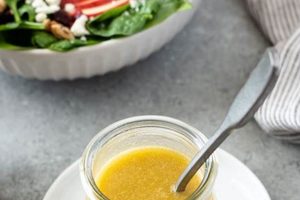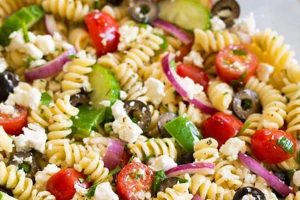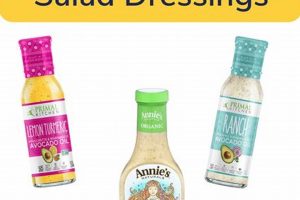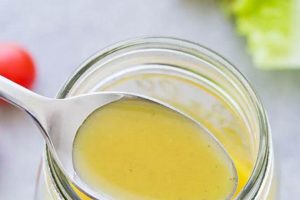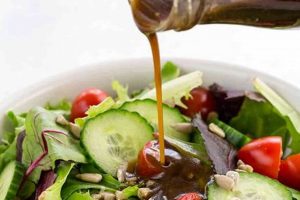Recipes for salad dressings that eschew animal products utilize ingredients like fruits, vegetables, nuts, seeds, herbs, and spices to create flavorful emulsions. For example, a simple vinaigrette might combine lemon juice, olive oil, and Dijon mustard, while a creamier dressing could incorporate blended cashews or avocado. These dressings offer diverse flavor profiles, from tangy and bright to rich and savory.
Dressings free of animal products cater to various dietary needs and preferences, including vegan, vegetarian, and dairy-free lifestyles. Such options often contribute fewer saturated fats and cholesterol compared to traditional dressings relying on dairy or eggs. Furthermore, the increasing awareness of environmental sustainability and animal welfare has propelled the development and popularity of these alternatives. This culinary shift reflects a broader trend toward plant-forward eating.
The subsequent sections will delve into specific formulation techniques, explore the versatility of various plant-based ingredients, and provide practical examples for crafting delicious and healthful dressings at home.
Tips for Crafting Plant-Based Salad Dressings
Creating flavorful and versatile plant-based salad dressings involves understanding key principles and utilizing readily available ingredients.
Tip 1: Embrace Acidity: Acidity balances richness and adds brightness. Consider lemon, lime, or vinegar sources. Experiment with apple cider vinegar for sweetness, red wine vinegar for robustness, or rice vinegar for a milder tang.
Tip 2: Explore Oil Options: The type of oil significantly influences flavor. Extra virgin olive oil provides a peppery note, while avocado oil offers a neutral base. Unrefined oils, like flaxseed or walnut, contribute distinct flavors but should be used sparingly due to their susceptibility to oxidation.
Tip 3: Harness the Power of Emulsifiers: Emulsifiers bind oil and water, creating a creamy texture. Tahini, Dijon mustard, and blended silken tofu serve as excellent plant-based emulsifiers. A small amount can drastically improve a dressing’s consistency.
Tip 4: Enhance with Flavor Boosters: Nutritional yeast adds a cheesy flavor, while miso paste imparts umami. Maple syrup or dates provide natural sweetness. Experiment with herbs, spices, and aromatics like garlic, ginger, and shallots to create unique profiles.
Tip 5: Utilize Nuts and Seeds: Soaking nuts and seeds before blending creates a smoother, creamier texture. Cashews, almonds, and sunflower seeds are excellent bases for rich and flavorful dressings.
Tip 6: Adjust Consistency: Achieve desired consistency by adding water, plant-based milk, or additional oil. Start with small increments to avoid over-thinning or excessive richness.
Tip 7: Taste and Adjust: Continuously taste and adjust seasonings throughout the process. Balance flavors by adding more acid, sweetness, salt, or spices as needed.
By following these guidelines, one can create diverse and flavorful plant-based dressings that complement a variety of salads and dishes.
These tips provide a foundation for creating flavorful, healthy, and versatile dressings. Further exploration of specific recipes and techniques will enhance one’s culinary repertoire.
1. Ingredients
Ingredient selection significantly impacts the flavor, texture, and nutritional value of plant-based salad dressings. A foundational understanding of core ingredient categories and their functionalities is essential for crafting successful recipes. These categories include oils, acids, emulsifiers, sweeteners, and flavor enhancers. The interplay between these components determines the final character of the dressing.
Oils, such as extra virgin olive oil, avocado oil, or flaxseed oil, provide the base and contribute to the dressing’s mouthfeel and flavor profile. Acids, including various vinegars and citrus juices, introduce brightness and balance richness. Emulsifiers, like tahini, Dijon mustard, or blended nuts, help bind oil and water, creating a stable and creamy texture. Sweeteners, such as maple syrup or dates, add complexity and balance acidity. Flavor enhancers, encompassing herbs, spices, garlic, ginger, and nutritional yeast, elevate the overall taste and create unique profiles. For instance, a lemon-tahini dressing utilizes tahini for creaminess, lemon juice for acidity, and garlic for a pungent note. Careful consideration of these ingredient categories and their interactions is crucial for achieving desired outcomes.
Effective recipe development requires a nuanced understanding of ingredient functionalities and their synergistic effects. Selecting high-quality ingredients and understanding their roles allows for precise flavor manipulation and textural control. This knowledge empowers culinary experimentation and the creation of diverse and satisfying plant-based salad dressings. Challenges may arise in balancing flavors or achieving desired textures, but understanding the role of each ingredient facilitates informed adjustments and successful outcomes.
2. Flavor Profiles
Flavor profiles are crucial in plant-based salad dressing recipes, dictating the overall sensory experience. A well-crafted dressing balances various taste elements, creating a harmonious complement to the salad’s ingredients. Understanding these profiles allows for informed ingredient selection and precise flavor manipulation.
- Sweet and Tangy
This profile balances sweetness and acidity. Fruit juices like orange or pineapple provide sweetness, while vinegar or lime juice contributes tartness. A maple-lime dressing exemplifies this profile, complementing salads with fruits and nuts. This balance prevents excessive sweetness or tartness, creating a refreshing and complex flavor.
- Savory and Earthy
This profile features earthy and umami notes. Ingredients like tahini, miso paste, or nutritional yeast contribute savory depth. A tahini-miso dressing, for example, offers a rich and nuanced flavor, pairing well with roasted vegetables or grain-based salads. The interplay of earthy and umami elements creates a grounding and satisfying experience.
- Spicy and Zesty
This profile incorporates heat and bright citrus notes. Chili flakes or jalapeos provide heat, while lemon or lime juice adds zest. A chili-lime dressing enhances salads with robust flavors, such as Southwestern or Asian-inspired dishes. The combination of spice and zest creates a vibrant and invigorating taste.
- Herbaceous and Bright
This profile highlights fresh herbs and vibrant acidity. Ingredients like basil, mint, or dill provide herbaceous notes, while vinegar or lemon juice adds brightness. A lemon-herb vinaigrette, for instance, offers a light and refreshing flavor, complementing salads with delicate greens or vegetables. The emphasis on fresh herbs and acidity creates a clean and invigorating sensory experience.
These flavor profiles represent a starting point for crafting diverse and delicious plant-based salad dressings. By understanding the interplay of different taste elements, one can create dressings that enhance and complement a wide range of salad ingredients and culinary styles. Further exploration of specific ingredients and techniques allows for personalized flavor combinations and endless culinary possibilities.
3. Preparation Methods
Preparation methods significantly influence the texture, emulsification, and overall quality of plant-based salad dressings. Different techniques yield distinct results, impacting the final sensory experience. Understanding these methods allows for informed choices based on desired outcomes.
Whisking, a fundamental technique, combines ingredients through rapid agitation. This method is ideal for vinaigrettes, where a light and slightly separated emulsion is desired. The simplicity of whisking makes it suitable for quick preparations. For example, a basic lemon vinaigrette benefits from whisking, maintaining a distinct separation of oil and vinegar.
Blending, often using a high-speed blender, creates smooth and creamy textures. This method is well-suited for dressings requiring emulsification of nuts, seeds, or tofu. The high-speed action thoroughly combines ingredients, resulting in a homogenous mixture. A cashew-based dressing, for instance, requires blending to achieve a creamy consistency and fully incorporate the cashew flavor.
Mortar and pestle grinding offers a traditional approach, releasing flavors and creating coarse textures. This method suits dressings incorporating whole spices or herbs. The grinding action breaks down ingredients, intensifying their aromatic qualities. A pesto-style dressing, for example, benefits from mortar and pestle grinding, maximizing the release of flavors from basil and pine nuts.
Choosing the appropriate preparation method depends on the desired texture and the specific ingredients involved. Whisking creates light and airy textures, blending yields smooth and creamy results, and grinding produces coarse textures with enhanced flavor release. Understanding these nuances enables informed decisions for achieving desired outcomes and creating a variety of plant-based salad dressings. Challenges can arise in achieving stable emulsions or desired textures, but informed method selection mitigates these issues and promotes culinary success.
Mastery of these techniques empowers the creation of diverse plant-based dressings, expanding culinary possibilities and enhancing the dining experience. The subsequent section will delve into dietary considerations relevant to plant-based salad dressing formulation.
4. Dietary Considerations
Dietary considerations play a vital role in formulating plant-based salad dressings, impacting ingredient selection and overall suitability for various dietary needs. Careful consideration of these factors ensures inclusivity and caters to a wider range of individuals. Understanding these considerations allows for informed recipe development and promotes healthier eating habits.
- Veganism
Veganism excludes all animal products, including honey and beeswax. Plant-based salad dressings inherently align with vegan principles, relying solely on plant-derived ingredients. This alignment makes these dressings a staple in vegan diets, providing flavor and nutritional value without compromising ethical or dietary restrictions. Common vegan ingredients include oils, vinegars, nuts, seeds, and plant-based sweeteners like maple syrup or agave nectar.
- Vegetarianism
Vegetarianism typically excludes meat, poultry, and fish, while allowing for animal products like dairy and eggs. While many plant-based dressings are inherently vegetarian, some may incorporate honey, which some vegetarians avoid. Careful ingredient selection ensures suitability for various vegetarian preferences. For example, a honey-mustard dressing would not be suitable for all vegetarians, while a maple-mustard dressing offers a suitable alternative.
- Gluten-Free Diets
Gluten-free diets exclude gluten, a protein found in wheat, barley, and rye. While most plant-based dressings are naturally gluten-free, certain ingredients, like soy sauce or malt vinegar, may contain gluten. Careful label reading and ingredient selection are crucial for ensuring gluten-free compliance. Substituting tamari for soy sauce or using apple cider vinegar instead of malt vinegar provides gluten-free alternatives.
- Allergen Considerations
Common allergens, such as nuts, soy, and seeds, are frequently used in plant-based salad dressings. Careful labeling and ingredient awareness are paramount for individuals with allergies. Providing allergen information allows for informed choices and prevents adverse reactions. For example, a nut-free dressing might utilize sunflower seeds or tahini as a base, while a soy-free option avoids soy sauce or tofu-based ingredients.
Addressing these dietary considerations ensures that plant-based salad dressings cater to a diverse range of individuals and dietary needs. Careful ingredient selection, clear labeling, and recipe adaptations allow for inclusive and accessible options, promoting healthy and enjoyable eating experiences for everyone. Understanding these nuances expands culinary possibilities and fosters a more inclusive approach to recipe development. This careful consideration of dietary needs further enhances the versatility and appeal of plant-based cuisine.
5. Storage Techniques
Proper storage techniques are essential for maintaining the quality, flavor, and safety of plant-based salad dressings. These techniques prevent spoilage, preserve nutritional value, and extend shelf life. Understanding these practices ensures optimal enjoyment and minimizes food waste.
- Container Selection
Appropriate containers play a crucial role in preserving dressing quality. Airtight containers, such as glass jars or sealed plastic containers, minimize oxidation and prevent contamination. Choosing the correct container size minimizes air exposure, further preserving freshness. For example, transferring a leftover vinaigrette to a smaller, airtight container prevents excessive oxidation and maintains flavor integrity.
- Refrigeration
Refrigeration is essential for most plant-based salad dressings, particularly those containing fresh ingredients like herbs or fruits. Cold temperatures inhibit bacterial growth and slow down enzymatic processes that contribute to spoilage. Storing dressings in the refrigerator maintains their quality and extends their shelf life. For instance, a blended avocado dressing should be refrigerated promptly to prevent browning and maintain its vibrant green color.
- Freezing (for select dressings)
While not all plant-based dressings freeze well, certain types, such as those with a nut or seed base, can be frozen for extended storage. Freezing preserves the flavor and texture of these dressings for later use. However, dressings with a high water content, like vinaigrettes, may separate upon thawing and are not ideal for freezing. A cashew-based dressing, for example, can be frozen in ice cube trays for portioned use, maintaining its creamy texture upon thawing.
- Thawing and Usage
Proper thawing techniques are essential for maintaining the quality of frozen dressings. Thawing in the refrigerator overnight allows for gradual and even temperature adjustment, minimizing texture changes. Once thawed, dressings should be used within a few days to maintain optimal quality. For example, a thawed tahini dressing should be stirred well to recombine any separated ingredients and ensure a consistent texture.
Implementing these storage techniques preserves the quality and extends the shelf life of plant-based salad dressings. Proper container selection, refrigeration, and appropriate thawing methods contribute to optimal flavor, texture, and food safety. Adhering to these practices minimizes waste and ensures enjoyable culinary experiences. These practices contribute to the overall success and enjoyment of plant-based culinary creations.
6. Creative Variations
Creative variations within plant-based salad dressing recipes offer opportunities to personalize flavors, explore diverse culinary traditions, and maximize nutritional value. These variations elevate dressings beyond basic formulas, transforming them into dynamic culinary expressions. Understanding the potential for creative adaptation empowers culinary exploration and expands the versatility of plant-based cuisine.
- Incorporating Global Flavors
Global cuisines offer a wealth of inspiration for innovative salad dressings. Drawing upon diverse flavor profiles expands culinary horizons and introduces unique taste experiences. For example, incorporating miso paste and ginger creates a Japanese-inspired dressing, while using harissa paste and cumin evokes North African flavors. These global influences add depth and complexity to plant-based dressings.
- Utilizing Seasonal Produce
Seasonal fruits and vegetables introduce vibrant flavors and maximize nutritional value. Adapting recipes to incorporate seasonal produce ensures optimal freshness and taste. For example, a summer dressing might feature blended strawberries and basil, while a fall dressing could incorporate roasted pumpkin and maple syrup. This seasonal approach celebrates the natural bounty of each season and adds variety to plant-based dressings.
- Experimenting with Herbs and Spices
Herbs and spices offer a vast spectrum of flavors and aromatic complexities. Experimenting with different combinations unlocks unique flavor profiles and elevates the sensory experience. For example, a simple vinaigrette can be transformed with the addition of fresh dill and lemon zest, while a creamy dressing benefits from the warmth of smoked paprika and cumin. Strategic use of herbs and spices adds depth and nuance to plant-based dressings.
- Adjusting Textures and Consistencies
Texture plays a crucial role in the overall sensory experience of a salad dressing. Adjusting textures through blending, whisking, or grinding allows for customized results. For example, a blended cashew dressing offers a smooth and creamy texture, while a whisked vinaigrette provides a light and slightly separated consistency. Understanding these techniques allows for precise control over texture and mouthfeel.
These creative variations highlight the adaptability and potential of plant-based salad dressing recipes. By incorporating global flavors, utilizing seasonal produce, experimenting with herbs and spices, and adjusting textures, one can create a diverse range of dressings that elevate salads and other culinary creations. These adaptations not only enhance flavor but also showcase the versatility and creativity possible within plant-based cuisine. Embracing these possibilities transforms simple dressings into culinary expressions, enriching the dining experience and promoting a deeper appreciation for plant-based ingredients.
Frequently Asked Questions
This section addresses common inquiries regarding plant-based salad dressing recipes, offering clarity and practical guidance for successful preparation and utilization.
Question 1: How can oil separation be prevented in vinaigrettes?
Oil separation is a natural occurrence in vinaigrettes due to the immiscibility of oil and water. Vigorous whisking or blending immediately before serving temporarily re-emulsifies the mixture. Adding a small amount of emulsifier, such as Dijon mustard or a blended date, can enhance emulsion stability.
Question 2: What are suitable alternatives to nuts in creamy dressings for individuals with allergies?
Sunflower seeds, pumpkin seeds, or silken tofu offer creamy textures and neutral flavors suitable for nut-free dressings. These alternatives provide similar consistency and functionality without compromising flavor or dietary restrictions.
Question 3: How can the shelf life of plant-based dressings be maximized?
Storing dressings in airtight containers in the refrigerator minimizes oxidation and microbial growth, extending shelf life. Selecting appropriate containers and maintaining consistent refrigeration temperatures are crucial for preserving freshness.
Question 4: Can plant-based dressings be used beyond salads?
Plant-based dressings offer versatility beyond salads, serving as marinades for vegetables, tofu, or tempeh. They can also function as dipping sauces for vegetables, chips, or crackers, or as flavorful toppings for cooked grains or roasted vegetables. Their adaptable nature expands their culinary utility.
Question 5: How can one adjust the sweetness or acidity of a dressing?
Small increments of sweeteners, such as maple syrup or agave nectar, increase sweetness, while additional acid, such as lemon juice or vinegar, enhances tartness. Gradual adjustments and continuous tasting ensure balanced flavor profiles.
Question 6: Are plant-based dressings inherently healthier than traditional dressings?
While plant-based dressings often contain fewer saturated fats and cholesterol compared to those using dairy or eggs, nutritional content varies based on specific ingredients. Careful ingredient selection and portion control contribute to overall dietary health.
Understanding these frequently asked questions facilitates successful preparation and utilization of plant-based salad dressings. This knowledge empowers informed choices, maximizes culinary potential, and promotes healthier eating habits.
This concludes the frequently asked questions section. The following section will provide a collection of plant-based salad dressing recipes.
Conclusion
Exploration of plant-based salad dressing recipes reveals their versatility, adaptability, and potential to enhance culinary experiences. From fundamental vinaigrette formulations to complex blended creations, these recipes offer a spectrum of flavors, textures, and nutritional profiles. Key aspects include careful ingredient selection, balanced flavor profiles, appropriate preparation methods, consideration of dietary needs, proper storage techniques, and creative variations. These elements contribute to successful outcomes and elevate plant-based dressings beyond basic condiments.
The increasing demand for plant-forward options underscores the significance of these recipes in contemporary culinary landscapes. Continued exploration and innovation within this realm promise further development of exciting and flavorful plant-based dressings, enriching dietary choices and promoting a more sustainable and compassionate approach to food consumption. Culinary experimentation and mindful ingredient utilization will undoubtedly drive further advancements in this dynamic and evolving culinary field.

